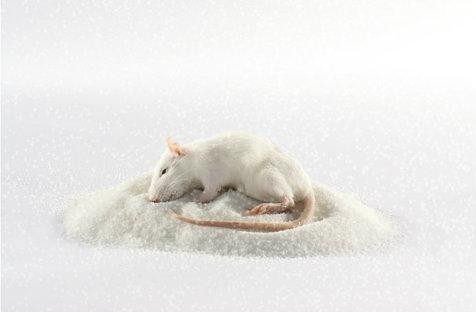The biennial Castlemaine State Festival has turned 19. The 2013 festival program features 350 artists, a host of visual arts exhibitions, 80 open studios, and a wide range of theatre and other events (covered in a separate review, here) over the course of 10 days.
Conveniently, the bulk of the festival’s visual arts components are located within a few blocks of Castlemaine Railway Station, which means a lot of the festivities are accessible by foot. Bicycle is an even better option and if you don’t have your own dual-wheeled transportation contraption, one can be hired from Festival Information on Mostyn Street. Of course, driving is also an option, allowing you to make a weekend of it and explore some of the festival gems that are just outside of town.
Before you even arrive at any of the festival sites, of which there are over 100, you’ll notice a remarkable sense of community spirit and pride in the community’s artistic endeavours: not just in the number of posters advertising the festival in the windows of businesses that you can’t imagine would benefit financially from the arts festival (including an accountant, a dental clinic and a podiatrist) but also the support that every second business has for the youth of the area, as paste-ups and school art projects are also on display. This level of unexpected generosity leaves you with a full, almost bursting heart, which is a lovely state to be in on a bright Sunday afternoon.
A must on the visual arts trail is Periscope, the festival’s Visual Arts Biennial, featuring 14 local and national artists and curated by Deborah Ratliff across three sites: the Hunt and Lobb building (an abandoned car salesroom), a former police lock-up, and the incredible Tutes Cottage, which in another life was a miner’s cottage.
Fittingly, Jason Waterhouse’s Glory Days sits in the Hunt and Lobb front window. Glory Days is a beat up, rundown 1972 HQ Holden Kingswood, its front left wheel reaching up elastically and sitting on a clean, broad, white plinth. It looks as pained and as stretched as an old person climbing stairs that are beyond the range of their mobility. The car’s metal bonnet and grill stretch impossibly, like plasticine, all the while keeping its dimensions, as though it’s been skewed on just one axis by a wrinkle or schism in reality or a small pull in the space-time continuum.
Not only does Waterhouse’s work laugh at solid matter and the supposed rigidness of reality (and this could be a tidy nod to Dali’s own melting and fluid objects), but it’s also a great stab at the rigid, macho ideals of the last generation of Aussie blokes, as the beloved symbol of masculine car culture is found out to be not completely ‘straight’; in fact, it’s a little bent and acting like an old proud diva, flauntingly propped up on a podium, openly a strange object, a queer object.
Also within the light-filled showroom of Hunt and Lobb is the beautifully whimsical and colour filled installation Return to Starlight by Tanya Schultz, sited within a small, Perspex-sealed office. The walls are decorated in pastels and fluorescent adhesive vinyl, cut into stars, arches, pyramids, diamonds, droplets, and clouds, spaced intermittently in the desolate void of the white wall. Every inch of the floor space has been covered in patterning and symbols made with lines of pigment and castor sugar, creating a bright, ornate yet frenetic covering for the hard, utilitarian concrete floor. Created in-situ the work feeds off the natural light streaming in from the glass frontage of the building, reflecting and emanating its psychedelic optimism: an aurora of solid shapes and patterns within a white sky.
A brief walk away, along a creek and a little uphill, surrounded by a perfectly unkempt combination garden, is Tutes Cottage, part Shire hobbit shack, part wizarding Weasley family holiday home, and originally inhabited by miners. I adore this kind of architecture, ad-hoc and perpetually repaired; it’s as though you are looking at a problem that is and has been in a constant state of being solved since it came into existence.
Tara Gilbee has installed site-specific installations within the cottage, using sound, glassware, projected light environments and vegetation to choreograph a laboratory that draws on science, electronics, alchemy and herbology. Despite the darkened rooms filled with bouquets of weeds hanging from the ceiling, jars humming and vibrating with electronically captured sound, and what could be eerie light dancing in the darkened spaces, there isn’t an air of supernatural ill-will; the spaces feel spiritually balanced, not spooky.
Kent Wilson occupies one of the centre rooms at Tutes, installing small contemplative structures filled with bound energy, mysticism, and harmony. The ancient power of the triangle (known to the Egyptians and mid-2000’s hipsters alike), having undergone a ritualistic baptism of fire, shadows a perpendicular empty space of sticks tied with red strings into triangles. This composition is supported by anchoring the structure on a taut line of string secured to a rock, a strong physical and symbolic foundation. The constructions appear to have function in the evidence of their making, perhaps shamanistic traps for capturing the metaphysical; they’re rudimentary spiritual tools without the flowery embellishments like those commonly seen on the dream-catchers and other power items belonging to new-age tourists.
These exhibitions at the Castlemaine State Festival have a limited lifespan, so don’t delay in visiting; procrastination won’t be rewarded, whereas an adventurous spirit will.
Castlemaine State Festival 2013
castlemainefestival.com.au
15 – 24 March





